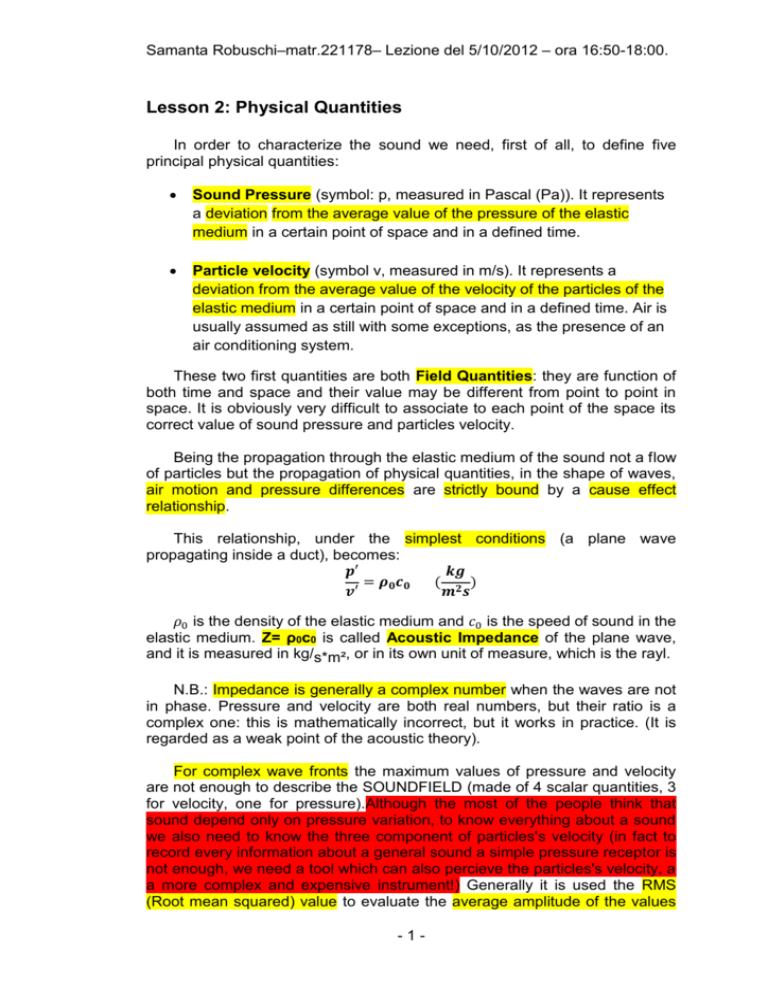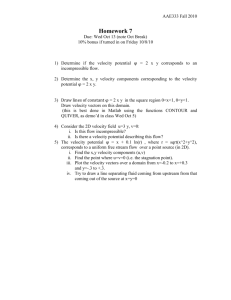Lesson 2: Physical Quantities
advertisement

Samanta Robuschi–matr.221178– Lezione del 5/10/2012 – ora 16:50-18:00. Lesson 2: Physical Quantities In order to characterize the sound we need, first of all, to define five principal physical quantities: Sound Pressure (symbol: p, measured in Pascal (Pa)). It represents a deviation from the average value of the pressure of the elastic medium in a certain point of space and in a defined time. Particle velocity (symbol v, measured in m/s). It represents a deviation from the average value of the velocity of the particles of the elastic medium in a certain point of space and in a defined time. Air is usually assumed as still with some exceptions, as the presence of an air conditioning system. These two first quantities are both Field Quantities: they are function of both time and space and their value may be different from point to point in space. It is obviously very difficult to associate to each point of the space its correct value of sound pressure and particles velocity. Being the propagation through the elastic medium of the sound not a flow of particles but the propagation of physical quantities, in the shape of waves, air motion and pressure differences are strictly bound by a cause effect relationship. This relationship, under the simplest conditions (a plane wave propagating inside a duct), becomes: 𝒑′ 𝒌𝒈 = 𝝆𝟎 𝒄𝟎 ( 𝟐 ) 𝒗′ 𝒎 𝒔 𝜌0 is the density of the elastic medium and 𝑐0 is the speed of sound in the elastic medium. Z= ρ0c0 is called Acoustic Impedance of the plane wave, and it is measured in kg/s*m², or in its own unit of measure, which is the rayl. N.B.: Impedance is generally a complex number when the waves are not in phase. Pressure and velocity are both real numbers, but their ratio is a complex one: this is mathematically incorrect, but it works in practice. (It is regarded as a weak point of the acoustic theory). For complex wave fronts the maximum values of pressure and velocity are not enough to describe the SOUNDFIELD (made of 4 scalar quantities, 3 for velocity, one for pressure).Although the most of the people think that sound depend only on pressure variation, to know everything about a sound we also need to know the three component of particles's velocity (in fact to record every information about a general sound a simple pressure receptor is not enough, we need a tool which can also percieve the particles's velocity, a a more complex and expensive instrument!) Generally it is used the RMS (Root mean squared) value to evaluate the average amplitude of the values -1- Lesson 2, 5/10/2012 – 16:50-18:00. of pressure and velocity, instead the simple medium value of this sizes, in a laps of time, doesn't give us any information because it is zero. 𝟏 𝑻 𝒑𝒓𝒎𝒔 = √ ∫ [𝒑(𝝉)]𝟐 𝒅𝝉 𝑻 𝟎 𝟏 𝑻 𝒗𝒓𝒎𝒔 = √ ∫ [𝒗(𝝉)]𝟐 𝒅𝝉 𝑻 𝟎 Both the RMS values have an energy meaning, being related to squared velocity (kinetic energy) and squared pressure (potential energy). The last three quantities we use to characterize the sound are energetic ones. They are usually averaged quantities, both in time and un space. Sound energy density (symbol D, measured in J/m3). It represents the energy contained in a cubic meter of the elastic medium. In case of plane, progressive waves the sound energy density is the sum of a kinetic and a potential contribution. 𝑫 = 𝑫𝑲 + 𝑫𝑷 𝑫𝑲 = 𝑬 𝟏 𝑱 = 𝝆𝟎 𝒗𝟐𝒓𝒎𝒔 ( 𝟑 ) 𝑽 𝟐 𝒎 Where Dk is the kinetic energy density and the RMS value of particles velocity is the same velocity of the piston. 𝟏 𝒑𝟐𝒓𝒎𝒔 𝑱 𝑫𝒑 = ( 𝟑) 𝟐 𝟐 𝝆𝟎 𝒄𝟎 𝒎 DP is the density of the energy stored due to the elastic compression of the medium (potential energy). Therefore: 𝑫= 𝑬 𝟏 𝒑𝟐𝒓𝒎𝒔 = [𝝆𝟎 𝒗𝟐𝒓𝒎𝒔 + ] 𝑽 𝟐 𝝆𝟎 𝒄𝟐𝟎 ( 𝑱 ) 𝒎𝟑 In the general case is required to know the Sound Field. Usually after a sound issues, for example when we speak, its energy can change from kinetic to potential during his travel, if the sound spread only through the air it would not lose energy (precisely it would happen in a long time). Sound Intensity (symbol I, measured in W/m2) -2- Lesson 2, 5/10/2012 – 16:50-18:00. Intensity is a vector quantity that measures the flow of a physical quantity through a surface; in particular the Sound Intensity is defined as the energy passing through the unit surface in one second: ⃗⃗(𝑷, 𝒕) 𝑰⃗(𝑷, 𝒕) = 𝒑(𝑷, 𝒕) ∙ 𝒗 In case of plane waves, Intensity is proportional to the energy density and to the speed through which the elastic medium flow through the section of the pipe. 𝑰 = 𝑫𝒄𝟎 Sound power (symbol W, measured in Watt (W)). The sound power is a measure of the capability of the sound source to radiate sound, while Sound Intensity and Density are measures of the effects of the radiations. One of the differences between sound power and the other properties that characterize the sound is that the power is a feature of the source, it is not affected by the enviroment in which it's sourounded, the power is an own feature of a sound source. Sound Power is measured using an indirect method: Considering a uniform intensity, thence I=W/A, but generally speaking the sound power W emitted by a sound source is given by the surface integral of the sound intensity I: 𝑾 = ∬ 𝑰⃗ ∙ ⃗𝒏⃗ 𝒅𝑺 And, if the total surface S can be divided in N elementary surfaces, each one characterized by a sound intensity : 𝑵 𝑾 = ∑ 𝑰 𝒊 ∙ 𝑺𝒊 𝒊=𝟏 Decibel Scale The decibel scale is a logarithmical scale used to express physical quantities related to Acoustic. The decibel scale it is mainly used in order to: Compress the huge dynamic range of the physical quantities: Human hearing threshold ÷ Pain Threshold I= 1pW/m2 (1012 ratio) I= 1W/m2 P= 20 μPa (106 ratio) P= 20 Pa Mimicking the human perception law: loudness doubles in our perception when intensity increases of a factor of 10. Make many operations easier. When expressed in decibel, physical quantities are followed by the term “level”: -3- Lesson 2, 5/10/2012 – 16:50-18:00. Sound pressure level: Lp = 10 log p2/prif2 = 20 log p/prif (dB), where prif = 20 Pa. It refers to the squared value of pressure because it is related to potential energy. Particle velocity level: Lv = 10 log v2/vrif2 = 20 log v/vrif (dB) where vrif = 50 nm/s. The squared value of velocity is related to kinetic energy. Sound intensity level: LI = 10 log I/Irif (dB) Irif = 10-12 W/m2 (hearing threshold: a negative value of Li can’t be heard by human). Propagating in different direction, LI is generally lower than the energy density level. Energy density level LD = 10 log D/Drif (dB) Drif = 3·10-15 J/m3. It is generally bounded between Lp and Lv. These 4 values refer all to how loud a sound is perceived, in case of plane progressive waves p/v= oco I = p2/oco =D·c0 Lp = Lv = LI = LD Picture 1- Loudness of sounds in Decibel scale. Sound Power Level: LW = 10 log W/Wrif (dB) Wrif = 10-12 W. W usually has a value higher than the other Levels and in case of a plane progressive wave it is bounded to the Intensity level by the relationship: 𝑳𝒘 = 𝑳𝒊 + 𝟏𝟎 𝐥𝐨𝐠 𝟏𝟎 𝑺 -4- Lesson 2, 5/10/2012 – 16:50-18:00. Where S is the area at the entrance of the pipe. If the surface area S represents the whole area through which the power flows away from the source, the relationship above is still valid, even when the waves are not plane, progressive ones. To define the dangerousness of a sound we should worry about the intensity we percive and not about the source's power (for example a train is a source of sound which could have a sound power level of two hundred of dB, but not a dangerous sound intensity level, it's because of the huge surface of the source). Picture 2- examples of typical values of pressure levels, in dB. -5-








